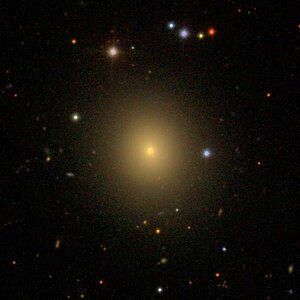NGC 5198
| Galaxy NGC 5198 |
|
|---|---|

|
|
| SDSS recording | |
| AladinLite | |
| Constellation | Hunting dogs |
|
Position equinox : J2000.0 , epoch : J2000.0 |
|
| Right ascension | 13 h 30 m 11.4 s |
| declination | + 46 ° 40 ′ 15 ″ |
| Appearance | |
| Morphological type | E1-2 |
| Brightness (visual) | 11.7 mag |
| Brightness (B-band) | 12.7 mag |
| Angular expansion | 2.0 ′ × 1.7 ′ |
| Position angle | 0 ° |
| Surface brightness | 13.1 mag / arcmin² |
| Physical data | |
| Affiliation | LGG 352 |
| Redshift | 0.008402 +/- 0.000017 |
| Radial velocity | (2519 +/- 5) km / s |
|
Stroke distance v rad / H 0 |
(116 ± 8) x 10 6 ly (35.7 ± 2.5) Mpc |
| history | |
| discovery | Wilhelm Herschel |
| Discovery date | May 12, 1787 |
| Catalog names | |
| NGC 5198 • UGC 8499 • PGC 47441 • CGCG 246-010 • MCG + 08-25-015 • GC 3576 • H II 689 • LDCE 0988 NED002 | |
NGC 5198 is a 11.7 likes bright elliptical galaxy from the Hubble type E1 in the constellation of the hunting dogs and about 116 million light-years from the Milky Way center.
It was discovered on May 12, 1787 by Wilhelm Herschel with an 18.7-inch reflector telescope, who described it as "pB, pL, R, mbM".
NGC 5198 group ( LGG 352 )
| Galaxy | Alternative name | Distance / million Lj |
|---|---|---|
| NGC 5198 | PGC 47441 | 116 |
| NGC 5169 | PGC 47231 | 113 |
| NGC 5173 | PGC 47257 | 112 |
| PGC 48012 | UGC 8597 | 112 |
